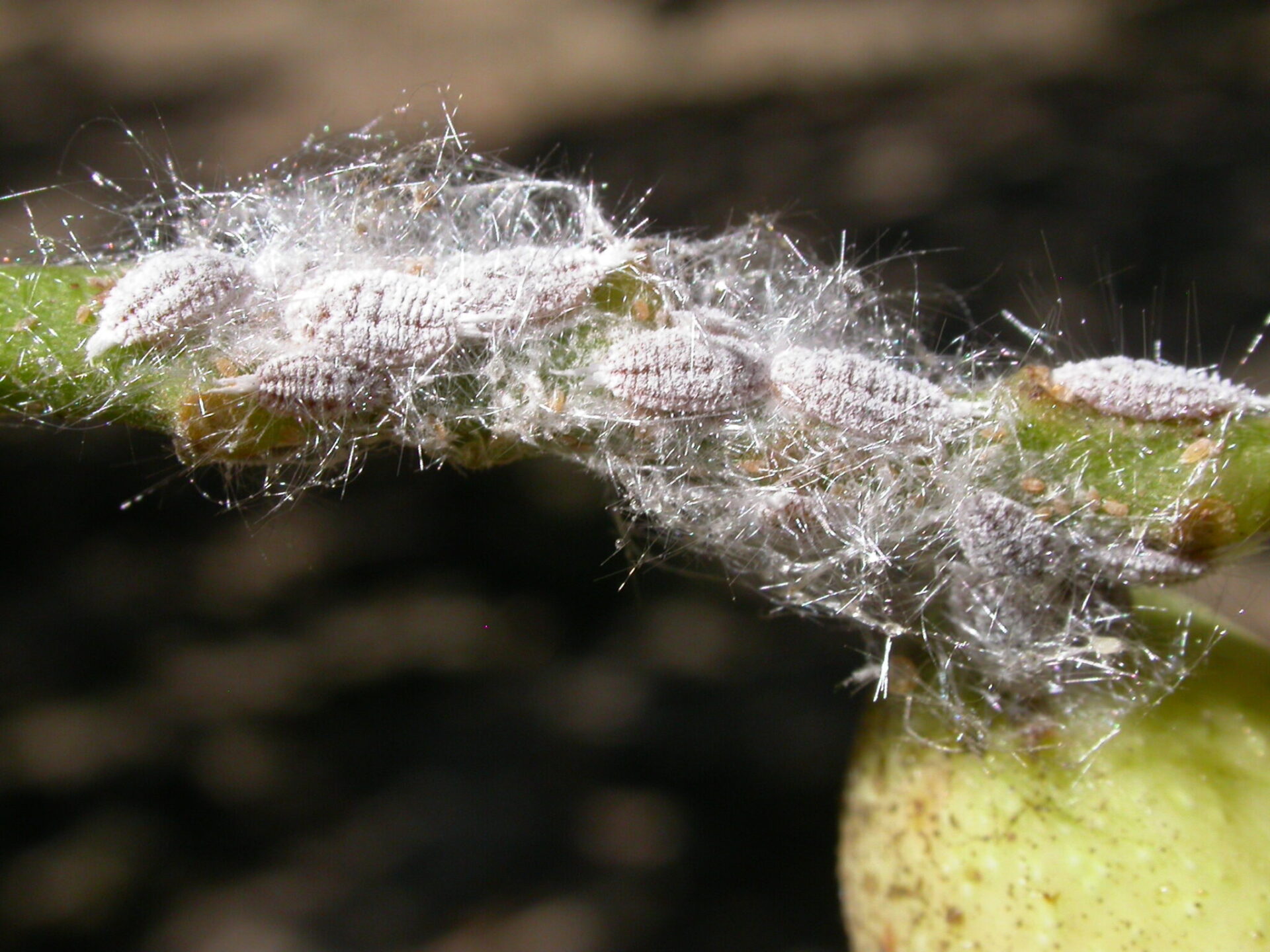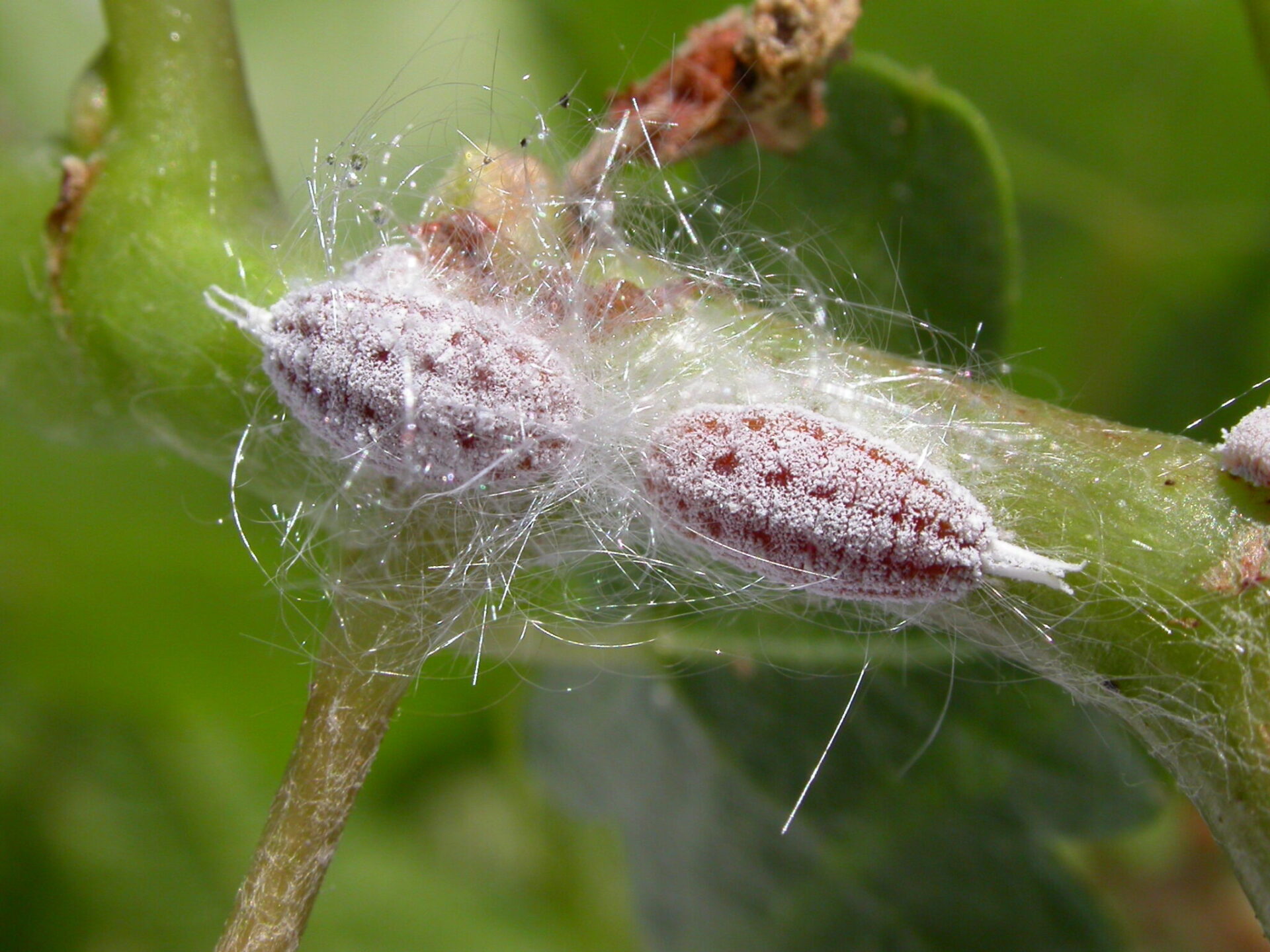
Infestations of Gill’s mealybug (GMB) in pistachio orchards cause sticky nut clusters, shell staining and reduced kernel weights. This pistachio pest feeds on plant juices, reducing the amount of carbohydrates available for nut development. The accompanying honeydew produced by GMB feeding leads to black sooty mold on leaves, reducing photosynthesis.
UCCE specialist Kent Daane said advisors have been hearing from pistachio growers about increasing rates of infestation. GMB, Ferrisia gilli, was first found in Tulare County pistachio orchards in 2000, and infestations were being controlled early in the growing season with an insecticide application, such as an insect growth regulator, timed for the crawler stage of the first generation. What has changed, Daane said, is that in recent years, the one spray application is not achieving the same level of control, and this appears to be across different types of insecticides. It is unlikely that resistance is developing from two materials with different modes of action, he said. One possibility is that larger nymphs or adults are now overwintering and producing the first instar earlier or later in the season. When the spray application is made, there are both early crawlers and later instars, and this this might lower spray effectiveness.
Identification
UC IPM guidelines state that the best time to find new mealybug infestations in an orchard is early fall through mid-winter. Population levels are at their highest at this time. Once leaves have dropped, white aggregations of mealybugs can be observed on the tree trunks and undersides of main scaffolds.
Those locations should be noted and checked at budbreak to see if any of the overwintering populations survived the winter. If mealybugs are present, they can be found at the bases of new buds on the trees. The locations should be marked and checked again in May.
The white waxy filaments covering adult females make this pest easy to find after harvest. Under the covering, GMB are 2 to 5 mm in length and pinkish grey in color. The white wax is secreted from a pore and creates the appearance of two dark stripes on their backs.
Three generations of GMB are produced in a year. The third generation crawlers are normally born live in mid-September to November and overwinter as small nymphs in the cracks and crevices on tree trunks. They come out in early spring and move to new buds. After maturing in May, they produce the first generation crawlers by early June, and these crawlers mature and produce the second generation in mid-July to August.
Nut clusters become infested with GMB from May through September. After harvest, adult females begin to migrate to the tree trunks and main scaffolds, forming the aggregations and white waxy look.
Treatment and Control
In orchards with a history of GMB infestations, monitoring for activity begins mid May. Decisions on treatment can be made by determining the number of adult female GMB per nut cluster. A three-year study led by David Haviland with UC IPM found that treatment in early June was economically justified if one GMB was found per 10 clusters in May.
The most effective timing for insecticides is when most GMB are in the crawler stage of the first generation. For the lower San Joaquin Valley, this typically occurs in late May to early June. Applications later in the season are more variable in effectiveness.
Biological control of GMB appears to be helping in almond and other crops, but Daane said insecticides aimed at controlling small and large bugs in pistachios might be harming the natural enemy populations.
Several species of predators and parasitoids that can suppress GMB in orchards have been identified by UCCE farm advisors David Haviland and Bob Beede. Predators include green lacewings and a small, brown coccinellid beetle whose larva mimics the appearance of a mealybug. Parasitoids include wasp species. They have been effective in reducing GMB populations, researchers note, in orchards where pyrethirin-based insecticide use is limited. Where pyrethrins are often used to control true bugs in pistachio orchards, they are rarely found.
Ant species found in the San Joaquin Valley gravitate to GMB infestations due to the honeydew their feeding produces. There is no research to show whether this association with ants is beneficial or harmful to the mealybugs. Ants feed on the honeydew and may protect the GMB from becoming parasitized.
Observations and Monitoring
Daane said GMB moves inside an orchard and from orchard to orchard via a number of routes. For example, orchard equipment, including harvest machinery, can transport GMB. The pest can also be moved about in bins.
An in-field observation by PCA Justin Nay of Integral Ag is that big blow ups of GMB are treated aggressively, and then a “monitor and manage” program is put in place in the orchard. Nay said that once introduced in an orchard, GMB tend to hang around, and populations rebuild over time to treatable levels.
What appears to happen in pistachio orchards, Nay said, is that no monitoring or treatment is done without visual evidence of a GMB infestation.
Eventually, he said, an infestation occurs due to GMB carried on equipment. It will likely not be noticed at first, as only a few trees may be involved. If GMB is spotted, it may only be due to visible infestations on trees near the equipment yard.
It is the second year after introduction in an orchard that GMB becomes noticeable. Those few infested trees that were missed the first year become multiple infested trees.
“It will get so ugly that that it can’t be missed by workers or growers,” Nay said. Even though infestations are highly visible, it may go untreated unless the grower or farm manager understands the damage GMB can cause.
Aggressive treatment generally doesn’t happen until the third year of the GMB infestation, Nay said. If the spring generation is successfully controlled, an every-other-year treatment program can be used. If the summer generation is treated, it is likely another treatment will be necessary in the spring. If populations are low, an every-other-row treatment will control GMB. There may be flare-ups in areas of the orchard with this approach, Nay warned.











